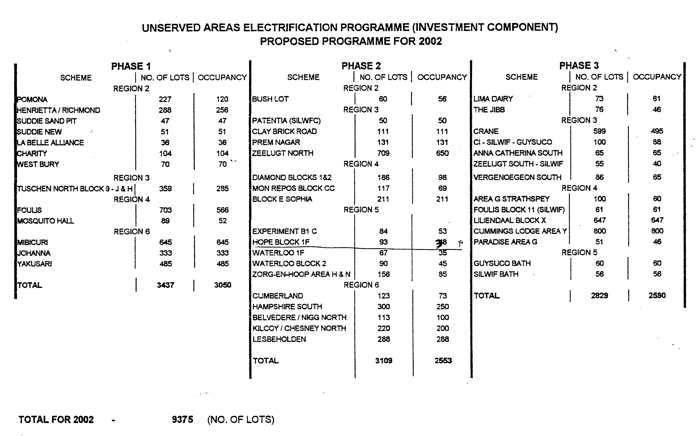
| Related Links: | Articles on GPL |
| Letters Menu | Archival Menu |

Explaining the genesis of the project, the PM said that normally the minimum average for connection close to the grid would be about $50,000 per household in populated areas close to existing distribution lines. However, this cost would rise to hundreds of thousands per household as the distance from distribution lines increases and houses are separated by greater distances. The government, he said, being aware that many citizens find it difficult to pay the full cost for obtaining electricity sought assistance to facilitate the necessary expansion.
He said that in the licence granted to GPL, government had required the company to contribute US$1 million per year for five years from its revenue stream; an expense charged to its rate base and as such a support from existing consumers.
However, this US$5 million only met part of the estimate to finance the extensive electrification programme, requiring that other avenues be examined.
The IDB, through a concessionary loan, agreed to provide the remaining finances to complete the programme.
The agreement, the PM said, allows for an acceleration of the development of the electricity sector over the period 2002-2006.
The $10,000 to be paid by persons receiving power will include charges for their meters, pipes supplying the cables and electric circuits at their buildings.
The PIU will be responsible for overseeing the successful implementation of all components of the project and will report to a Project Steering Committee (PSC) to be structured on the executive and ministerial levels, which will provide guidance on strategic and policy issues relevant to the project.
The executive level of the PSC, Hinds said, will comprise representatives of the ministries of Finance, Housing and Water and Local Government, GPL and the principal project coordinator. The PM will chair the ministerial level of the PSC and it will include the ministers of Housing and Water, Finance and Local Government, the chairman of the executive level and principal project coordinator as the secretary.
The project is expected to be executed in three components namely investment, hinterland and institutional strengthening and capacity building. The first will entail, among other things, the extension of distribution networks to provide power to customers in the targeted 221 coastal and inland communities. The PIU and Office of the Prime Minister will be responsible for overall monitoring and evaluation of the component.
This component will also see the procurement of material (some 85% of which is said to be foreign based), survey and preparation of site maps, design of networks, construction of distribution networks and the connection of service lines and meters. A programme to sensitise consumers, particularly the new ones on the safe use of power and on its conservation will be conducted.
Selection of areas to receive power, the PM said, would be done according to established criteria and procedures to ensure maximum impact.
“The government, IDB and GPL have agreed on criteria to ensure that the project achieves maximum benefits,” he said, remarking that the Ministry of Housing is to be the lead agency in this aspect. Consideration will also be given to the length of time the area has been in existence and the extent to which the area is populated, along with the need for distribution to be equitably spread across all the areas among the various regions. Squatter settlements, Hinds said, would need to be regularised before being electrified to avoid having to redo work once the scheme is finalised.
Costs to provide electricity to a house or cluster should be less than $200,000 for it to be considered. The hinterland project preparation component will see the financing of a study to determine options and requirements for electrification of such areas. This study, Hinds remarked, will, among other things, gather information to assess the feasibility for hinterland electrification and examine methods, including community participation, of managing hinterland power projects. Based on that study three to five demonstration projects in selected hinterland communities will be conducted.
Monitoring and evaluation, along with the provision of vocational training and technical and institutional assistance to sector agencies so as to enable them to effectively support the project implementation, will form part of the institutional strengthening and capacity building component. Sectors to benefit in this component include the government electrical inspectorate, the Environmental Protection Agency and the Public Utilities Commission.
Hinds used the opportunity to encourage residents in areas to be serviced to save their $10,000 contribution along with monies for wiring, expected to be on average $15,000 to $20,000. He also urged then to exercise patience as the work is to be done in a phased way. He reminded them that without the project it would have cost them over $100,000 to receive power.
Bembridge saw the signing as a milestone in the continued development of the country.
He reminded of the significant role being played by the institution which has grown steadily over the years since the country became a member in 1976.
GPL’s Chief Executive Officer, John Lynn, welcomed the opportunity to work with government and the local communities in the project.
According to Lynn, up to the end of June some 1,600 customers have already paid the necessary connection fee, with almost 1,400 having thus far been supplied with electricity. “To date approximately 1400 poles have been planted, 70 km of primary and secondary cable and 120 transformers have been installed,” the GPL CEO said.
GPL, he said, intends to provide a network to facilitate up to 7,000 connections during 2003 in east and west Berbice and West Demerara.